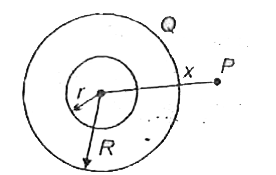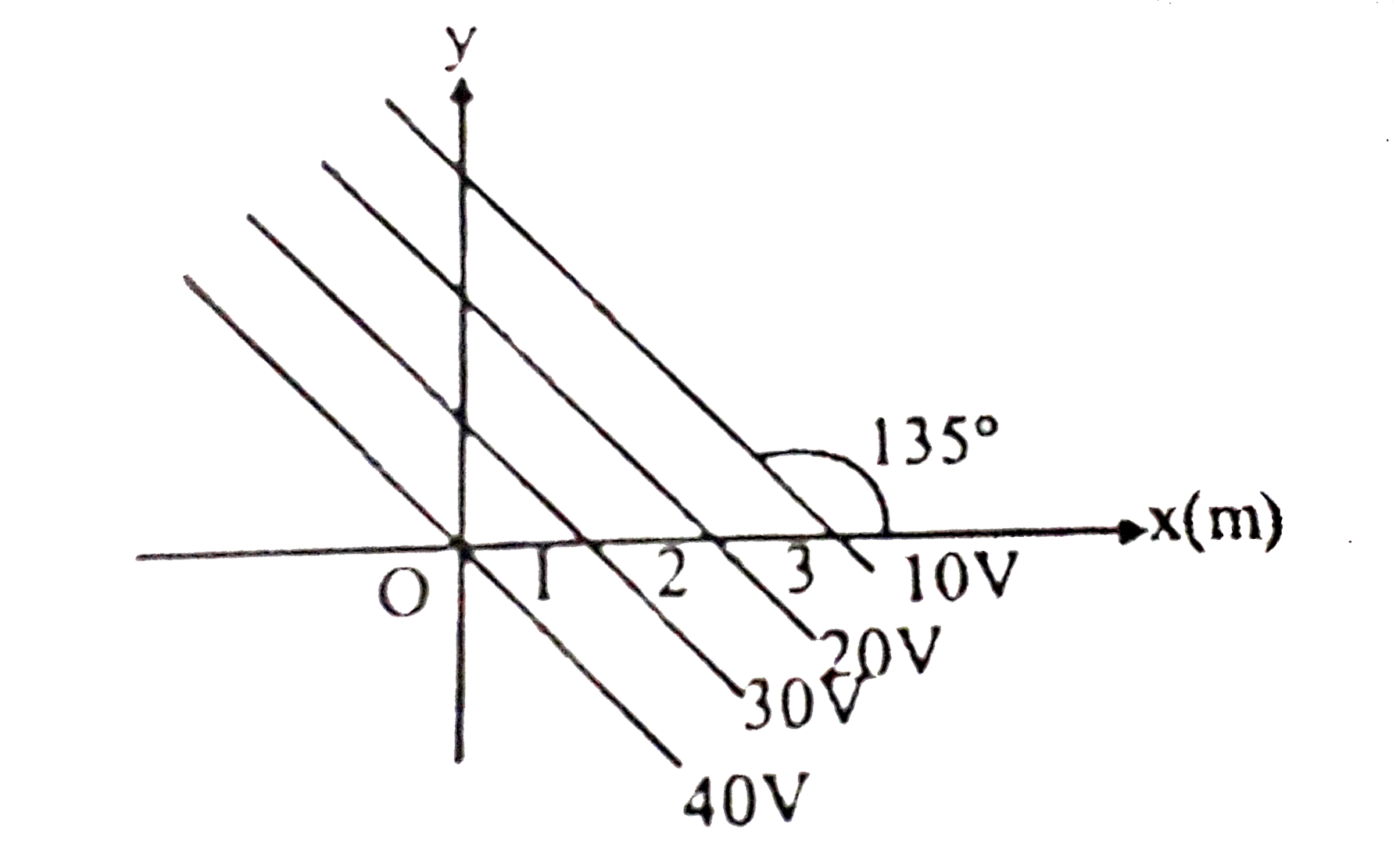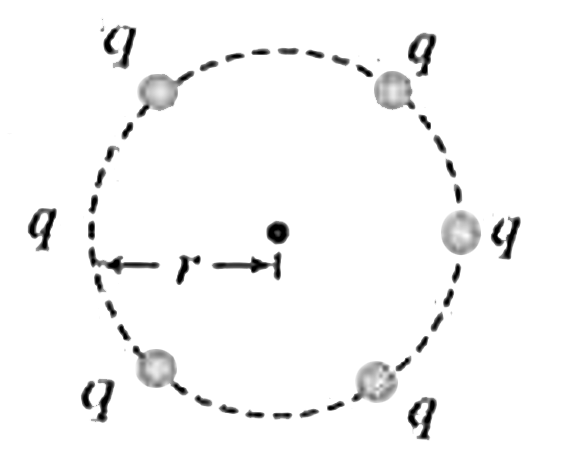Complete Solutions to ASSIGNMENT SECTION - A of chapter ELECTROSTATIC POTENTIAL AND CAPACITANCE of Class 12 book with complete answers and questions
| Class 12 | PHYSICS |
| Chapter | ELECTROSTATIC POTENTIAL AND CAPACITANCE |
| AAKASH INSTITUTE | ASSIGNMENT SECTION - A |
| Number Of Questions | 44 |
| Academic Year | 2023-24 |
Three equal charges are placed at the three corners of an isoscles triangle as shown in the figure. The statement which is true for electric potential `V` and the field intensity `E` at the centre of the triangle-

View SolutionThe potential at a point 0.1 m from an isolated point charge is + 100 volt. The nature of the point charge is
View SolutionA charge of 10`mu`C is placed at the origin of x-y coordinate system. The potnetial difference between two point (0, a) and (a, 0) in volt will be
View SolutionFour charges of same magnitude q are placed at four corners of a square of side a . The value electric potential at the centre of the souare will be (where k = `(1)/(4 pi epsilon_(0))` )
View SolutionTwo identical positive charges are placed at `x=-a` and `x=a`. The correct variation of potential V along the x-axis is given by
View SolutionWhich graph best represents the variation of electric potential as a function of distance from the centre of a uniformly charged solid sphere of charge of radius R ?

View SolutionA hollow charged metal sphere has radius `r`. If the potential difference between its surface and a point at a distance `3r` from the centre is V, then electric field intensity at a distance `3r` is
View SolutionTwo concentric hollow conducting spheres of radius r and R are shown. The charge on outer shell is Q. what charge should be given to inner sphere so that the potential at any point P outside the outer sphere is zero ?

View SolutionThe ptoential gradient is a
View SolutionThe electric potential V at any point x,y,z (all in meters) in space is given by `V = 4x^2` V. The electric field at the point (1m, 0, 2m) is ……….. `Vm^(-1)`
View SolutionFigure shows a set of equipotential surfaces. The magnitude and direction of electric field that exists in the region is-

View SolutionDetermine the electric field strength vector if the potential of this field depends on X, coordinates as V = 10 axy
View SolutionIf on the x - axis electric potential decreases uniform from 60 V to 20 V between x = -2 m to x = +2 m then the magnitude of electric field at the origin
View SolutionAn infinite sheet of charge has surface charge density `sigma` . The separation between two equipotential surfaces, whose potential differ by V is:
View SolutionTwo small spheres, each carrying a charge q are placed r m apart and they interact with force F. If one of the sphere is taken around the other once in a circular path, the work done will be equal to
View SolutionWork done in moving a charge q coulomb on the surface of given charged conductor of potential V is
View SolutionIf an alpha particle and a proton are accelerated from rest by a potential difference of 1MeV, then the ratio of their kinetic energies will be
View SolutionWhat will be electric potential at any point on the perpendicular bisector of an electric dipole?
View SolutionThe work done in moving an electric charge q in an electric field does not depend upon
View SolutionA particle A has charge `+q` and a particle B has charge `+4q` with each of them having the same mass `m`. When allowed to fall from rest through the same electric potential difference, the ratio of their speed `(v_(A))/(v_(B))` will become
View SolutionIf 50 joule of work must be done to move an electric charge of 2 C from a point, where potential is V volt, the value of V is
View SolutionA proton has a mass 1.67 `xx 10^(-27)` kg and charge `+ 1.6 xx 10^(-19)`C. If the proton is accelerated through a potential difference of million volts, then the kinetic energy is
View SolutionThe electric potential at a distance of 3 m on the axis of a short dipole of dipole moment `4 xx 10^(-12)` coulomb-metre is
View SolutionThe electric potential in volt due to an electric dipole of dipole moment `2 xx 10^(-8)` coulomb-metre at a distance of 3m on a line making an angle of `60^(@)` with the axis of the dipole is
View SolutionAn electric dipole of length `2cm` is placed with its axis making an angle `30^(@)` to a uniform electric field `10^(5)N/C` .If it experiences a torque of `10sqrt(3)`Nm ,then potential energy of the dipole ..
View SolutionTwo electrons each moving with a velocity of `10^(6) ms^(-1)` are released towards eachother. What will be the closest distance of approach between them ?
View SolutionCharges`-q , Q, and -q` are placed at an equal distance on a straight liner. If the total potential energy of the system of three charges is zero, then find the ratio `Q//q`.
 .
.
View SolutionA point charge is surrounded symmetrically by six identical charges at distance `r` as shown in the figure. How much work is done by the forces of electrostatic repulsion when the point charge `q` at the centre is removed at infinity ?

View Solution1000 small water drops each of capacitance C join togethter to form one large spherical drop. The capacitance of bigge sphere is
View SolutionTwo parallel air capacitors have their plate areas `100 cm^2" and "500 cm^2`, respectively. If they have the same charge and potential, and the distance between the plates of the first capacitor is 0.5 mm, what is the distance between the plates of the second capacitor?
View SolutionA dielectric slab is inserted between the plates of a capacitor. The charge on the capacitor is `Q` and the magnitude of the induced charge on each surface of the dielectric is `Q'`.
View SolutionTwo charged capacitors have their outer plates fixed and inner plates connected by a spring of force constant 'K'. The charge on each capacitor is q. find the extension in the spring at equilibrium

View SolutionA battery does 200 J of work in charging a capacitor. The energy stored is.
View SolutionThe following arrangement consists of five identical metal plates parallel to each other. Area of each plate is `A` and separation between the successive plates is `d`. The capacitance between P and Q is

View SolutionTwo similar conducting balls having charges + q and - q are placed at a separation d from each other in air. The radius of each ball is r and the separation between their centres is d (d `gt gt ` r ). Calculate the capacitance of the two ball system

View SolutionA capacitor is half filied with a dielectric (K = 2 ) as shown in figure A. if the same capacitor is to be filied with same , what would be the thickness of dielectric so that capacitor still has same capacity ?

View SolutionCapacitors `C_(1)(10 mu F) and C_(2) (20 mu F) ` are connected in series across a 3 kV supply, as shown. What is the charge on the capacitor `C_(1)` ?

View SolutionIn the circuit below `C_(1) = 20 mu"F , " C_(2) = 40 mu` F and `C_(3) = 50 mu` F . If no capacitor can sustain more than 50 V, then maximum potential difference between X and y is

View SolutionIn the circuit shown below `C_(1) = 10 mu"F, " C_(2) = C_(3) = 20 mu`F, and `C_(4) = 40 mu` F. if the charge on `C_(1) ` is `20 mu`C then potential difference between X and Y is

View SolutionWould the charge change,if the plates were pulled without battery?
View SolutionIn the circuit below, if dielectric is inserted inot `C_(2)` then the charge on `C_(1)` will

View SolutionA capacitor with plate separation d is charged to V volts. The battry is disconnected and a dielectric slab of thickness `(d)/(2)` and dlelectric constant '2' is inserted between the plates. The potential difference across its terminals becomes
View SolutionAn uncharged parallel plate capacitor having a dielectric of dielectric constant `K` is connected to a similar air core parallel plate capacitor charged to a potential `V_(0)`. The two share the charge, and the common potential becomes `V`. The dielectric constant `K` is`
View SolutionTwo indentical capacitors are joined in parallel, charged to a potential V, separated and then connected in sereies, the positive plate of one is connected to the negative of the other. Which of the following is true ?
View Solution
ASSIGNMENT SECTION - A questions and complete solutions for chapter ELECTROSTATIC POTENTIAL AND CAPACITANCE of AAKASH INSTITUTE ENGLISH of Class 12
All Exercises from AAKASH INSTITUTE Class 12 PHYSICS ELECTROSTATIC POTENTIAL AND CAPACITANCE
- ASSIGNMENT (SECTION-A) Objective Type Questions (Only one answer)
- ASSIGNMENT SECTION - A
- ASSIGNMENT SECTION - B
- ASSIGNMENT SECTION - C
- ASSIGNMENT SECTION - D
- COMPREHENSION-II
- EXAMPLE
- EXERCISE
- SECTION-B (OBJECTIVE TYPE QUESTIONS (ONLY ONE ANSWER) )
- SECTION-B(OBJECTIVE TYPE QUESTIONS(ONLY ONE ANSWER) )
- SECTION-C (OBJECTIVE TYPE QUESTIONS (More than one answer))
- SECTION-D(COMPREHENSION-I)
- SECTION-E (Assertion-Reason Type Questios)
- SECTION-F(MATRIX-MATCH TYPE QUESTIONS)
- SECTION-G(INTEGER ANSWER TYPE QUESTIONS)
- SECTION-H Multiple True-False Type Questions
- SECTION-I Subjective Type Questions
- SECTION-J Aakash Challengers Questions
- TRY YOURSELF